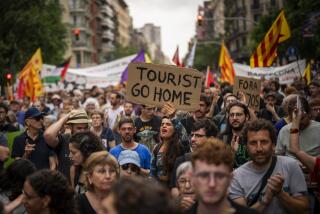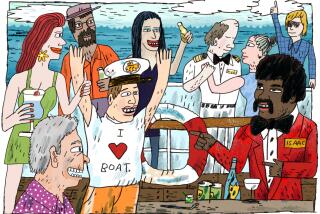Going Dutch in Curacao
- Share via
WILLEMSTAD, Curacao — Think Caribbean and you’re likely to think British or Spanish, maybe French. My husband and I have sampled each island nationality, and last year we were looking for something different. Dutch, it turned out.
The choice arose when I saw a line in a guidebook that pronounced Curacao “the most important island architecturally in all the West Indies.”
Hmmm. . . . Never having been to the Netherlands, we’d never seen Dutch architecture. Curacao is outside the hurricane belt, I read; English is spoken and cars drive on the right. Three more pluses. When we discovered that the island’s pre-Lenten Carnival coincided with our vacation dates, that clinched it. Curacao it would be.
The island, 35 miles off the Venezuelan coast, is a popular port of call on Caribbean cruises. (We flew there.) For ship passengers docking in the capital of Willemstad, the Dutch touch is evident immediately. Along one side of the harbor is Handelskade, a quay lined with tall, narrow buildings in the Dutch colonial style, painted in tropical pastels and topped by baroque curved gables. The sight makes a first and lasting impression of Curacao and has earned it a place on UNESCO’s roster of World Heritage Sites.
Our first priority was checking into the guest house we’d selected from literature sent us by the Curacao Tourist Board.
Luxury accommodations aren’t important to us. Convenient location, economical rates and rubbing elbows with local people are. In print, the Buona Sera Inn, a 15-room guest house less than a 10-minute walk from downtown, sounded ideal. In person, it proved to be just that.
Our room was bare-bones but spotless. It included a queen-size bed and two singles, night tables, chair, an alcove to hang clothes, air conditioner and private bath (cold water only). Windows with a view of the Caribbean helped compensate for the cold showers and sparse furnishings. The price: $47 a day. For a few dollars more, guests could have breakfast or lunch in the dining room; there also was a small lounge with TV.
Hastily stashing our bags in our room, we headed out for the Handelskade. The buildings, their sinuous roof lines highlighted by the strong sunlight, were as appealing as advertised. But they weren’t the only sights to marvel at from the Handelskade.
The harbor, St. Anna Bay, divides Willemstad into two parts: Punda, site of the original settlement, and Otrobanda. They are connected by two very different bridges.
The Queen Emma, a low wooden pontoon bridge for pedestrians, swings open as often as 30 times a day to allow ship traffic through. No matter how often my husband, the engineer, watched it, he remained fascinated by the mechanics of its operation. When the Emma is open, a free ferry shuttles pedestrians across.
Beyond the Emma is the modern Queen Juliana Bridge, which arcs skyward almost 200 feet above the bay. Until recently, this was high enough for most cruise ships to pass beneath. A new terminal is being built to accommodate the growing number of megaships.
During our 17-day visit we stopped almost daily at the Tourist Office, which was between our guest house and downtown--often enough for the cheerful staff to teach us a little Papiamento. That’s the bewildering local dialect--a smorgasbord of Portuguese, Dutch, Spanish, English and West African words--spoken here and on neighboring Aruba and Bonaire.
Soon we were greeting residents with Bon dia (good morning), straight from the Portuguese, and asking Con ta bai? (How are you?).
Identifying the sources of Papiamento words we saw became a game. Kaya, the word for street, clearly came from the Spanish calle, as did awa from agua, meaning water.
A Tourist Office employee told us that 80% of Curacao’s visitors are European; only 20% are American. In her experience, Americans preferred nearby Aruba because of the many beach resorts where they’re pampered. “Americans are less interested in learning of island culture,” she said. “Europeans rent a car, get out and see everything.”
Our goal exactly. While Willemstad’s duty-free shopping is the big attraction for cruisers, Curacao’s unusual past and multifaceted present are what held our attention.
A Dutch colony since the 1600s, Curacao and neighboring Bonaire plus two and a half tiny islands east of Puerto Rico make up the self-governing Netherlands Antilles.
For centuries, just about every European trading power operated here--unfortunately, slave traders among them. This melange of roots endures today not only in the Papiamento language--the locals are schooled in Dutch and most also speak English or Spanish--but in the food and customs, and in the relaxed racial ambience.
The majority of the people we encountered seemed to have African ancestry, as did our hosts at the Buona Sera, the Dap family. And Carnival was definitely an Afro-Carib affair in the music, costumes and all-out exuberance.
One of our first excursions was to Ft. Amsterdam, built in 1634, near the pontoon bridge. Inside the fort is the still-occupied Governor’s Mansion and the fort church; the staircase outside the church, we discovered, offered an overall view of the whole complex.
Another day, our destination was the Mikve Israel-Emanuel Synagogue, built in 1732, the oldest synagogue in continuous use in the Western Hemisphere. The interior is impressive, with its brass and mahogany fittings, but it’s the floor that sets this synagogue apart: It’s covered with a thick layer of sand that the Jewish community has been importing from the Holy Land for centuries.
A short walk away is the formerly wealthy residential quarter of Scharloo, where many of the early Jewish merchants built handsome homes. The houses, ranging from colonial to Victorian, are gradually being restored. Among the gems is a dark green Victorian confection called the Wedding Cake House; a Star of David set within an iron gate recalls an owner of long ago.
Otrobanda, on the other side of the Emma Bridge, has its share of noteworthy buildings. It also has a reputation of risk for purse snatching off the main avenues. We dealt with that challenge by taking a tour with Joop Hart, a school principal and part-time guide whom we found through the Tourist Office.
“Willemstad’s buildings are as much a blend of influences as the Papiamento language,” he told us. “Bell-shaped gables, typically Dutch, Spanish arches and shutters can all exist in the same house.”
Our own ramblings took us window-shopping in the boutique-lined streets behind the Handelskade, and to the Floating Market where schooners from Venezuela tie up to sell their cargo of fruits and vegetables.
One day we joined office and shop workers and a sprinkling of tourists at the communal tables in the Old Market. We enjoyed the goat stew; chicken, beef stew and fried fish were also on that day’s menu. Even better was the opportunity to chat with locals.
We also enjoyed the Amstel beer brewed on the island. “You don’t have to pay for it if it tastes salty,” one waiter joked. The local Amstel is said to be the only beer in the world brewed from desalinated seawater, which is the source of the entire island’s water supply.
Our dining ran the gamut: market fare one day, fish with polenta and ratatouille the next in the posh, hilltop Ft. Nassau Restaurant, and then rijsttafel, a Dutch colonial specialty from the East Indies, a rice-based banquet of more than a dozen side dishes.
Early on, we discovered a van parked between the market and post office selling carry-away fresh fruit salad--mango, papaya, watermelon, cantaloupe, passion fruit and pineapple--and we bought some whenever we were in the neighborhood.
One night at the Bay Sight Restaurant on the second floor of the Otrobanda Hotel and Casino, I ordered kesho yena. In this traditional dish, a round of Gouda cheese is stuffed with raisins and a spicy chicken filling, then baked.
The open-sided restaurant faced right onto the bay. Good as the food was, it couldn’t compete with the spectacle that unfolded as we ate; nothing could have. Out of the darkness a cruise ship blazing with lights glided toward us. The closer it came, the more it resembled a mid-size skyscraper lying on its side. It seemed near enough to touch. Watching the ship traffic by day was interesting; by night, mesmerizing.
Public buses were handy for excursions outside the capital. One took us to the Curacao Seaquarium, a few miles east of the city. Its 46 tanks contain more than 400 marine creatures, but the big attraction is the Animal Encounter: For $55 you get a wetsuit and air tank and jump into a natural tidal pool to swim among fish and stingrays, then hand-feed giant tortoises and sharks through metal fencing. Although people with no diving experience are welcome to participate, we preferred to watch the action from the underwater observatory, a submerged boat-like cabin with many windows.
We rented a car for a few days to see the rest of the island, which is 38 miles long and two to seven miles wide. The landscape is mostly scrub brush and cactus; rainfall averages only 22 inches annually. Driving up the southwestern shore, we admired the beaches along Daaibooi Bay and Knip Bay. It was Sunday, the day for Curacaoans to enjoy themselves.
Dominating the western end of the island is the 1,200-foot peak of Christoffel National Park, which has miles of marked hiking and nature trails. For us, the best part was watching the surf crash against the rocky cliffs. Just outside the park’s northeast side, at Boca Tabla, the Caribbean has carved a stone grotto. We went in and watched the breakers endlessly advancing and retreating.
Sightseeing took a back seat on the Sunday before Ash Wednesday and the beginning of Lent, when the Grand Carnival Parade takes over the streets of Willemstad.
Spectators had staked out their turf hours before the parade was due to begin. Lacking chairs, we asked whether the seats set up one row deep along the parade route were for rent. No, said a woman presiding over metal scaffolding rigged with chairs, planks, benches and a plastic sun shade. People pay the parade committee so much per meter in advance to set up seating. “But,” she added, “you’re welcome to sit with us.”
At first we declined, but on second thought that seemed rude, so we settled in. Watching the parade as part of that family is as memorable as the parade itself, an exuberant extravaganza of melody, rhythm, color, dance, high spirits and costumes far more elaborate than we expected.
Then Carnival was over, and so was our vacation. Leaving Curacao, we said not goodbye, but ayo.
(BEGIN TEXT OF INFOBOX / INFOGRAPHIC)
GUIDEBOOK
Dropping In on Curacao
Getting there: American Airlines flies from Los Angeles to Curacao with a connection in Miami. Round-trip fare starts at $738.
Among the cruise lines stopping in Curacao: Holland America, telephone (800) 426-0327; Royal Caribbean/Celebrity, (800) 327-6700; Norwegian, (800) 327-7030; and Princess, (800) 421-0522.
Where to stay: We were comfortable at the Buona Sera Inn, tel. 011-599-9- 461-8286.
A brochure listing lodgings and amenities, from hotels to guest houses, is available from the Curacao Tourist Board, 475 Park Ave. S., Suite 2000, New York, NY 10016; tel. (800) 328-7222; fax (212) 683-9337; e-mail: ctdbny@ ctdbny.com.
When to go: This year’s Grand Carnival Parade is on Feb. 14; the Farewell Parade (nighttime), Feb. 16.
For more information: Internet: https://www.curacao-tourism.com.
More to Read
Sign up for The Wild
We’ll help you find the best places to hike, bike and run, as well as the perfect silent spots for meditation and yoga.
You may occasionally receive promotional content from the Los Angeles Times.






